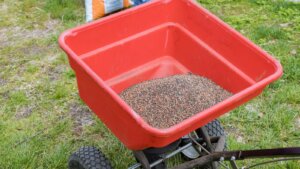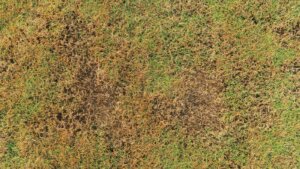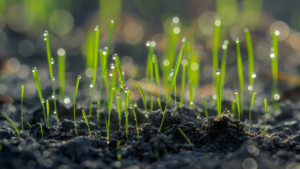Creating the perfect lawn in Collegeville, PA, is an art that begins with choosing the right moment to plant your grass seed.
Whether rejuvenating an existing lawn or starting anew, understanding lawn care nuances is essential. The ideal germination window varies with the type of grass seed and local climate conditions. In Collegeville, where the air temperature fluctuates significantly from early spring to late fall, timing your seeding is crucial.
Planting Grass Seed: Timing Is Key
- Cool-season grass seeds thrive best when sown at a soil temperature near 60 degrees Fahrenheit, typically just after the danger of frost has passed. This preparation period is vital for new lawns to establish robust root systems and resist common challenges like weed control and bare spots. Remember, your lawn’s future health hinges on these early decisions: choosing when and what type of grass seed to plant—be it turfgrass or a specific cool-season variety—decisive factors in achieving a lush, green canvas for your outdoor space.
- Warm-season grasses, thriving in higher air temperatures typically above 80 degrees Fahrenheit, are best sown in late spring or early summer. This timing aligns with their optimal germination period when the soil warms up, ensuring they establish before the heat peaks. Understanding this key distinction in grass types provides a healthy, vibrant lawn for homeowners looking to revitalize or seed a new lawn. Correctly timing the planting after the danger of frost has passed sets the stage for a season of lush growth and robust new seedlings.
Expert Recommendations for Optimal Results
According to the Penn State Extension, the optimum times for turf seeding in Pennsylvania are mid to late spring and late summer to early fall. This recommendation aligns with the natural growth cycles of cool-season grasses predominant in the Collegeville area. Additionally, they advise using starter fertilizers judiciously to provide your new lawn with the essential nutrients it needs to thrive. Another key tip is to delay mowing until the grass reaches about three inches in height. This practice allows the grass to establish a deeper root system, which is fundamental for a healthy and durable lawn.
Preparing for Planting
Before you scatter those seeds, preparing your lawn is crucial for successful germination and growth.
- Soil Testing: Start with a soil test to determine the pH and nutrient levels. This step is essential to understand what your lawn might be lacking and how to address it.
- Aeration: If your soil is compacted, aerating your lawn can improve oxygen flow, vital for new roots to thrive.
- Leveling the Lawn: Ensure your lawn is level by filling in any low areas with sand, topsoil, and compost. This preparation prevents water from pooling and damaging your new grass.
In preparing your lawn for seeding, it’s crucial to focus on creating the ideal conditions for germination.
Proper soil preparation facilitates the initial sprouting of grass seeds and plays a significant role in the time it takes for the new lawn to be established. It involves ensuring your soil has the right pH, nutrient balance, and proper aeration and leveling. These steps give the seeds an optimal environment to germinate effectively, leading to a uniformly lush lawn.
Remember, the effort you put into preparing your lawn before seeding can dramatically influence the health and appearance of your grass in the following seasons.
Seeding and Post-Planting Care
With your lawn prepped, it’s time to seed. Use a seed spreader to ensure even distribution, and avoid planting before a forecasted heavy rainfall or on windy days to prevent seeds from washing or blowing away.
- Watering: After seeding, regular watering is vital. However, be mindful not to overwater, which can lead to poor germination and growth.
- Mowing: Wait until your new grass is about three inches tall before the first mow. This patience allows the grass to establish itself.
Your Guide to a Vibrant Lawn in Collegeville, PA
Embarking on the quest for a verdant lawn in Collegeville, PA, is about planting seeds and nurturing them through each critical phase. As you embrace the journey, keep these pivotal points in mind:
- Selecting the Right Seed: Choose between cool-season and warm-season varieties based on Collegeville’s unique climatic conditions.
- Optimal Planting Time: Plant cool-season grass seeds when soil temperatures approach 60 degrees Fahrenheit, and warm-season seeds as temperatures rise above 80 degrees.
- Preparation is Key: Conduct soil testing and lawn aeration to ensure optimal conditions for seed germination.
- Careful Watering and Mowing: Regular but cautious watering and delaying mowing until grass reaches about three inches are vital for newly planted lawns.
- Leveraging Starter Fertilizers: Use starter fertilizers judiciously to provide essential nutrients during the critical early stages of lawn establishment.
By focusing on these essential elements, you can significantly enhance the growth and health of your lawn, ensuring a lush, thriving outdoor space throughout the growing season.



